 Instagram
Instagram
Access
Headquarters
(Koganei, Tokyo)
Kashima Space
Technology Center
(Kashima, Ibaraki)
SOTA Project : Small Optical TrAnsponder
Small Optical TrAnsponder(SOTA)
Earth observation data obtained by satellites is currently transmitted to ground stations as radio waves. Issues with using radio waves, including interference and low carrier frequencies, pose obstacles to higher communication rates. Space optical communications technology is expected as a solution to these issues.
As part of its longstanding research efforts in space optical communications, NICT developed SOTA (Small Optical TrAnsponder), a compact optical transponder suitable for loading on micro satellites.
Launched in May 2014 with SOCRATES (Space Optical Communications Research Advanced TEchnology Satellite), SOTA operated until November 2016.
In satellite-to-earth optical communications, atmospheric fluctuation encountered during the propagation of optical signals through the atmosphere is problematic. Atmospheric fluctuation is a randomly occurring natural phenomenon and predicting the occurrence of it is known to be difficult.
NICT uses SOTA to obtain data on optical propagation between satellites and earth stations and by analyzing the data obtained, promotes research toward practical applications of space optical communication technologies in the future.
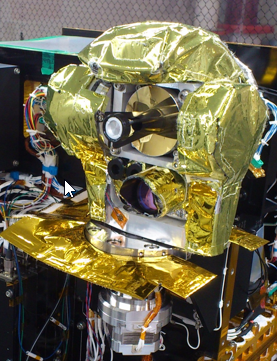
Technical Description
1. Features
- World’s first successful satellite-to-earth optical communication experiment on a microsatellite
- Designed to be compact and lightweight and to consume minimal power, SOTA is suitable for loading on microsatellites (world’s smallest gimbal-mounted optical communication system)
- Orientation control by biaxial drive mechanism
- Multiple laser light sources of varied wavelengths
- Joint experiments with overseas space research institutes
2. Configuration
Figures 1 and 2, respectively, are external overviews of SOTA and the control system. Table 1 gives specifications for SOTA.
SOTA uses four types of laser sources: TX1 and TX4 are used for communications, including image data transmission. TX2 and TX3 are used for polarimetry and are suitable for basic experiments toward future applications of quantum key distribution technologies.
Communication rates are selectable between 1 Mbps and 10 Mbps, and an NRZ (non-return to zero) format is used as the transmission method.
In satellite-to-ground communications, SOTA receives (detects) and tracks lasers of 1,064 nm wavelength.
SOTA also incorporates two types of error correcting codes; Reed-Solomon code and low-density generator matrix (LDGM) code.
|
Laser wavelength |
TX1 |
976 nm |
|---|---|---|
|
TX2 and TX3 |
800 nm-band |
|
|
TX4 |
1549 nm |
|
|
RX |
1064 nm |
|
|
Communication rate |
1 Mbps or 10 Mbps |
|
|
Transmission method |
On-off keying(NRZ) |
|
|
Receiver’s opening diameter |
4.5 cm |
|
|
Gimbal driving range |
Az: ±50 deg. |
|
|
Power consumption |
1.7 W to 12.6 W |
|
 External view of Small Optical TrAnsponder(SOTA)
External view of Small Optical TrAnsponder(SOTA)
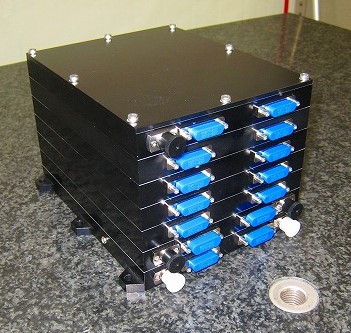 External view of Control system
External view of Control system
3. Success Criteria
Table 2 shows the success criteria for SOTA. Four stages from minimum success to extra success were set with respective criteria.
For the minimum success stage, since SOTA is partially composed of commercial off-the-shelf (COTS) components, the initial requirement was mainly to confirm the activation of SOTA and ancillary devices.
All experiments from the minimum success to full success stages were successfully completed by 2015 and most of the experiments from the extra success stage were completed in the following years.

|
Minimum success |
|
Verification of system activation |
|
Integrity verification of optical sensors and other devices |

|
Success |
|
Tracking tests |
|
Trials for acquisition of optical propagation data |
|
Trials for BER measurement |

|
Full success |
|
Trials for data transmission |
|
Encoding trials |

|
Extra success |
|
Trials for measuring polarization characteristics |
|
Trials with multiple optical ground stations |
|
Demonstrations of optical command implementation |
4. Experiment Details
Figure 3 shows the diagram of SOTA experimental system configuration.
Preliminary preparations include generating data in orbit such as image data and error correction data and uploading control commands to the satellite in advance to orient it to the target ground station when it appears over the ground station.
SOTA becomes ready for the experiment when the satellite appears over the ground station.
When the ground station irradiates the satellite with a beacon, SOTA detects and tracks the direction of the beacon, then transmits a laser beam for communications. This is how data is transmitted for satellite-to-earth optical communications. During the experiment, SOTA keeps tracking the optical beacon continuously transmitted by the ground station.
Figure 4 is an image of the satellite observed from the ground station. Figure 5 is a photograph of the Earth captured by a camera mounted on the satellite and sent to the station via optical communications.
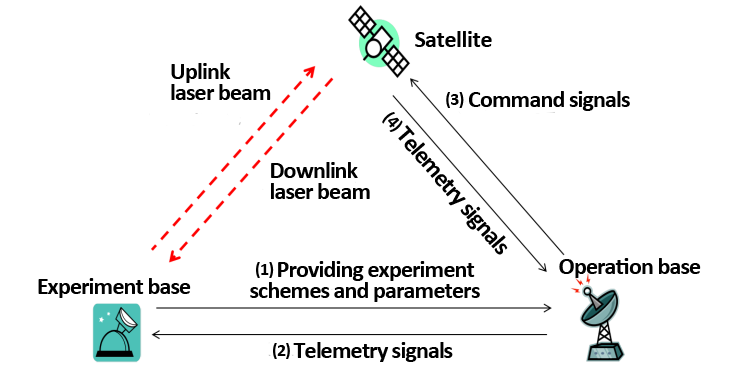 Experimental system configuration
Experimental system configuration
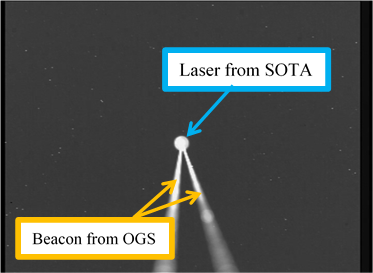 Satellite as observed from ground station
Satellite as observed from ground station
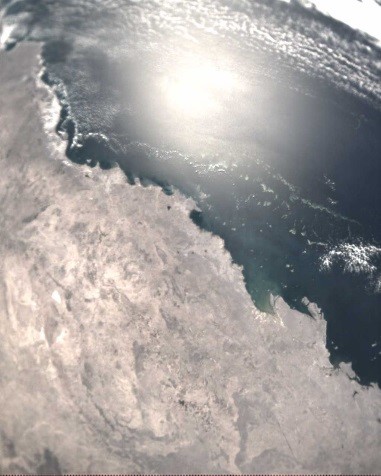 Image of Earth captured by satellite camera and sent via optical communications
Image of Earth captured by satellite camera and sent via optical communications
Publications
- H. Takenaka, A. Carrasco-Casado, M. Fujiwara, M. Kitamura, M. Sasaki, and M. Toyoshima, “Satellite-to-ground quantum-limited communication using a 50-kg-class microsatellite,” Nat. Photonics, vol. 11, pp. 502–508, 2017.
- Carrasco-Casado, H. Takenaka, D. Kolev, Y. Munemasa, H. Kunimori, K. Suzuki, T. Fuse, T. Kubo-Oka, M. Akioka, Y. Koyama, and M. Toyoshima, “LEO-to-Ground Optical Communications using SOTA (Small Optical TrAnsponder) –Payload Verification Results and Experiments on Space Quantum Communications–,” Acta Astronaut., vol. 139, pp. 377–384, 2017.
- Carrasco-Casado, H. Kunimori, H. Takenaka, T. Kubo-Oka, M. Akioka, T. Fuse, Y. Koyama, D. Kolev, Y. Munemasa, and M. Toyoshima, “LEO-to-ground polarization measurements aiming for space QKD using Small Optical TrAnsponder (SOTA),” Opt. Express, vol. 24, no. 11, p. 12254, 2016.
- H. Takenaka and M. Toyoshima, “Study on optical communication link design for 50kg-class small satellites,” in International Conference on Space, Aeronautical and Navigational Electronics, 2010, vol. 2, no. SANE2010-98, pp. 179–184.
- M. Toyoshima, H. Takenaka, Y. Shoji, Y. Takayama, Y. Koyama, and M. Akioka, “Small optical transponder for small satellites,” in Communication Systems Networks and Digital Signal Processing, 2010, pp. 558–561.
- H. Takenaka, M. Toyoshima, Y. Shoji, Y. Takayama, Y. Koyama, and M. Akioka, “Link budget analysis for small optical transponder onboard small satellites,” in International Astronautical Congress, 2010, pp. 1–8.
- Y. Koyama, Y. Takayama, M. Akioka, H. Takenaka, Y. Munemasa, and M. Toyoshima, “Completion of the small optical transponder development for satellite-ground laser communication demonstrations,” in Ka Conf. and ICSSC, 2013, pp. 1–6.
- H. Takenaka, E. Okamoto, and M. Toyoshima, “Low-density Generator Matrix Code for Correcting Errors with a Small Optical Transponder,” in International Conference on Space Optical Systems and Applications, 2015, pp. 1–4.
- H. Takenaka, M. Toyoshima, Y. Takayama, Y. Koyama, and M. Akioka, “Experiment plan for a small optical transponder onboard a 50 kg-class small satellite,” in International Conference on Space Optical Systems and applications, 2011, pp. 113–116.
- D. H. Phung, E. Samain, N. Maurice, D. Albanesse, H. Mariey, M. Aimar, G. M. Lagarde, G. Artaud, J. L. Issler, N. Vedrenne, M. T. Velluet, M. Toyoshima, M. Akioka, D. Kolev, Y. Munemasa, H. Takenaka, and N. Iwakiri, “Telecom & scintillation first data analysis for DOMINO - Laser communication between SOTA, onboard socrates satellite, and MEO OGS,” in IEEE International Conference on Space Optical Systems and Applications, 2016, vol. 9739, pp. 1–14.
- H. Takenaka, M. Toyoshima, Y. Shoji, Y. Takayama, Y. Koyama, and M. Akioka, “Evaluation of the optical communication system for Small Optical TrAnsponder (SOTA) based on the laboratory,” in International Astronautical Congress, 2011, vol. 62.
- Y. Koyama, M. Toyoshima, Y. Takayama, H. Takenaka, K. Shiratama, I. Mase, and O. Kawamoto, “SOTA: Small Optical Transponder for micro-satellite,” in International Conference on Space Optical Systems and Applications, 2011, pp. 97–101.
- H. Takenaka, D. Kolev, Y. Koyama, and M. Akioka, “EXPERIMENTAL RESULTS OF SATELLITE-TO-GROUND LASER COMMUNICATIONS LINK THROUGH ATMOSPHERIC TURBULENCE USING SOTA,” in International Conference on Space Optics, 2016, pp. 1–7.
- H. Takenaka, Y. Koyama, M. Akioka, D. Kolev, N. Iwakiri, H. Kunimori, A. Carrasco-Casado, Y. Munemasa, E. Okamoto, and M. Toyoshima, “In-orbit verification of small optical transponder (SOTA): evaluation of satellite-to-ground laser communication links,” in Proc. SPIE, 2016, p. 973903.
- Y. Takayama, M. Toyoshima, Y. Koyama, H. Takenaka, M. Akioka, K. Shiratama, I. Mase, and O. Kawamoto, “Current development status of Small Optical TrAnsponder (SOTA) for satellite-ground laser communications,” in Proc. SPIE, 2012, p. 824607.
- D. R. Kolev, H. Takenaka, Y. Munemasa, M. Akioka, N. Iwakiri, Y. Koyama, H. Kunimori, and M. Toyoshima, “Overview of International Experiment Campaign with Small Optical TrAnsponder (SOTA),” in International Conference on Space Optical Systems and Applications, 2015, pp. 1–6.
- A. Carrasco-Casado, H. Takenaka, M. Fujiwara, M. Kitamura, M. Sasaki, and M. Toyoshima, “QKD from a microsatellite: The SOTA experience,” Quantum Inf. Sci. Sensing, Comput. X, no. May, p. 10, 2018.
- M. Akioka, H. Takenaka, M. Toyoshima, Y. Koyama, Y. Takayama, and T. Seki, “The NICT’s New OGS for Satellite Laser Communication and SOTA/SOCRATES experiment,” in SpaceOps Conferences, 2016, pp. 1–6.
- A. Carrasco-Casado, H. Takenaka, D. Kolev, Y. Munemasa, H. Kunimori, K. Suzuki, T. Fuse, T. Kubo-Oka, M. Akioka, Y. Koyama, and M. Toyoshima, “LEO-to-Ground Optical Communications using SOTA (Small Optical TrAnsponder) –Payload Verification Results and Experiments on Space Quantum Communications–,” in International Astronautical Congress, 2016, pp. 1–7.
- H. Takenaka, M. Toyoshima, Y. Takayama, Y. Koyama, M. Akioka, E. Okamoto, and T. Kyo, “Study on Error Coding Program for Implementation in SOTA,” in International Conference on Space Optical Systems and Applications, 2012.
Support us
Collaborate with us
Use this technology
CONTACT
If you have any questions for the Space Communication Systems Lab., please contact us by using our inquiry form.
 Instagram
Instagram
Copyright © 2019 Wireless Networks Research Center. All Rights Reserved.